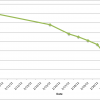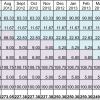The Dollar Challenge
Corey at 20’s Finances proposed that PF bloggers fit a typical month’s budget into a general set of eight categories so that he could compile the data and compare across groups. He asked us to normalize our spending to a single dollar to obscure income levels. If you want to participate you can find his divided dollar and links to other people’s on his post. It was very interesting to me even to see the categories that Corey chose. It must have been a difficult balance between the desire for specificity and the desire for generalizability.
This challenge was actually quite challenging for me! I had a few troubles and observations:
- It was very difficult for me to find a “typical” month! Looking back over the past six months, in each month we’ve traveled or had a big expense come up. I ended up just choosing October because it was the most recent and I could most easily remember the details. As Corey suggested, I took our large one-time payment of a parking permit and divided it into the monthly installment due only for October.
- The eight delineations aren’t divided out the same way I keep track of them in our budget. For example, I separate Housing into Rent and Utilities (I feel strange putting cell phones under housing). I also place our two types of Insurance coverage under their respective objects – renter’s insurance under Utilities and car insurance under Transportation. There’s no right or wrong here, it’s just interesting to see how someone else organizes those expenses.
- There are no categories for Giving or Travel, which are two of the major components of our dollar.
- Because of the complicated way I transfer money in and out of short-term savings accounts, we save a lot but we also spend out of our savings accounts. To avoid double-counting money I saved but also intend to “spend” in a typical month, I recorded them as “spending” in one of the first six categories, if applicable, and subtracted the amounts from what we actually saved in October. For example, we pay car insurance twice per year, but every month we save a bit of money toward that bill. So I counted that monthly installment (to self) as spending under Insurance instead of under Savings.
- Our Savings rate looks huge, but much of it would be re-categorized as Other or in additional categories if they existed, because we intend to spend a large chunk of that savings in the next year, for instance on Travel.
- In October we “spent” more money than we took in as income (105.0%), at least according to my calculation here. Since this calculation is neither the real month of October (because I split up the parking permit payment, for instance) nor our budget (since we went over in Groceries, for one) it’s a Frankenstein’s monster of two realities and isn’t fully accurate. Because I zero out our checking account every month I can assure you we actually came in under budget in October.
- All of these are percentages of our take-home (after tax) pay.
Housing: $0.32
Our rent is 25% and our utilities are 7%. Our utilities include electricity, water and sewer, cell phones, and internet. We don’t have cable, just bunny ears. These are pretty fixed expenses.
Food: $0.115
We spent about 35% more on groceries this month than in a typical month because we hosted a party (provided all the food) and brought a snack for about 75 people to a local ESL class. (I estimated how much the class actually consumed and recategorized it under giving, but the leftovers still spiked our grocery bill.) The groceries component is 9.5%, eating out is 1%, and saving for our yearly Community Supported Agriculture subscription is 1%
Transportation: $0.05
3% went to gas, 1% went to an emissions check for renewing one car’s registration, and 1% went toward our parking permits. The latter two came out of a savings account. Our cars are fully paid for.
Insurance: $0.025
Just auto (2%) and renter’s/property (rounds to 0%) in this category. We typically don’t have to pay anything related to health care or health insurance (just rare copays). We don’t have dental coverage and only a small amount of vision reimbursement per year so we have a savings account for those expenses when they come up.
Personal Care: $0.005
The only expenditure in October that I could categorize as personal care was some dry-cleaning, which we do only a couple times per year (and I pulled this amount from a savings account).
Entertainment: $0.015
This month we went to the State Fair for an evening and got a video game from Redbox (both very atypical and accounting for 0.5%). The bulk of our Entertainment spending (1%) is on season tickets to the Broadway musicals performed at our local theater and to splitting a season ticket to our university’s men’s basketball games. All of these expenses come our of our Entertainment savings account. We also have a Netflix subscription, but it is a gift.
Savings: 32.5%
There is an important distinction here! I really only consider 17% of our take-home pay to be saved. That is what we contribute to our Roth IRAs. The other 15.5% goes to our short-term savings accounts and will eventually be spent. For instance, we save about 12% of our take-home pay to our Travel account alone. The other 1% is likely split between personal care and entertainment in a way I can’t delineate for October.
Other: $0.175
We gave away 13.5% of our take-home pay in October, most of it to our church. We spent another 2.5% on gifts (one wedding and one birthday) and 2.5% renewing my passport (both came out of savings accounts). The remaining percent was a university activity fee and a VGA adaptor.
How do our budget categories compare to yours? Are giving and travel single-category-worthy expenses to you? Do your months easily converge to your budget or do you have a lot of “atypical” months?
photo by loleia
Filed under: budgeting, participation


 One Small Thing Challenge December 2011
One Small Thing Challenge December 2011 I’ve Joined the Yakezie Challenge! (Update)
I’ve Joined the Yakezie Challenge! (Update) Poll: Budgets Are a Tool, After All – How Do You Use Yours?
Poll: Budgets Are a Tool, After All – How Do You Use Yours? Targeted Savings Account Calculation: Cars through Aug2013
Targeted Savings Account Calculation: Cars through Aug2013


Thanks for joining the challenge! You’re right – better late than never!
Cool idea! If I do this at some point I’ll let you know our %s. A few questions, would I count car registration fees under transportation? (I’d need to divide my yearly payment by 12, I suppose.) And YES! Travel is a single category for us… when we’re attending 3- 6 weddings a summer, and then visiting two families 1-2 times/year (each), costs become significant! These things would also be interesting to chart over time, as lifestyle and location change. I feel like my housing and food costs are significantly less now than they were when I was living in Los Angeles. 🙂
Yes, I counted all car-related expenses under Transportation including once-yearly ones like taxes and registration. We pay all of that out of our “Cars” savings account so the calculation was easy – our monthly savings rate plus average spent on fuel.
I know, it’s crazy how much we spend on travel. It’s borderline irresponsible. Why’d we have to fall in love with boys who lived so far away?!
I don’t even want to think about how much our costs will go up when we move back to CA. That’s one of the purposes of this blog – to worth through the readjustments we’ll have to make with an extreme increase in cost-of-living. I suppose the cost of flights might go down relatively since we’ll be flying out of a more major airport. 🙂
[…] Money Crush Help Me To Save My Broken Coin Change on a Budget Word Of Finance Cecile’s Piggy Bank Always the Planner DQYDJ Rambling Fever Money Savings Your 20s in Your 20s Broke and Fat Budgeting in the Fun Stuff Simple Rich Living Thriftability Good Cent Savings Freedom Thirty-Five Ultimate Smart Money Money Q & A Invest it Wisely Evolving PF […]
Here’s the breakdown of our dollar:
Housing: $0.17
Transportation: $0.03
Food: $0.12
Insurance: $ 0.02
Personal Care: ?*
Entertainment: ?*
Savings: $0.35
Other (travel + charitable giving): $0.16
*Unaccounted for: $0.15
So, since I’m not a super savvy budgeter, I couldn’t tease out Entertainment and Personal Care expenses (these would likely be, triathlon entry fees, athletic clothing, etc. for us!), and lumped it all into the “Unaccounted” section. I redefined “other” to be charitable giving and travel. Savings is our roth IRA investments + “short term savings” as you say, but it usually gets saved “for real” every few months in one of our other longer-term savings accounts when I get around to it.
Just a quick comparison… when I was living in Marina del Rey, rent alone (including water and trash, but not electricity/gas or internet) was 27% of my take-home income. Now, rent = 13%, and internet, water, and electricity = 4%. Such a difference!
Wow, you do have low housing costs! Is that on par for your city or did you seek out an inexpensive abode? It sounds like your housing in Marina del Ray was still very reasonable for your income but yeah, you lucked out moving to the South!
What are you saving for long-term aside from retirement? So far we only have our Roths but before we graduate I think we’ll want to start saving for our next car and/or a down payment, both of which are a least a couple years off. All our short-term savings has a 1 yr or less timeline.
I think housing costs are on par, or slightly lower than usual for here. Location was key in our selection process (to be near the Amtrak for when we were traveling to/from Atlanta more often), and so I could ride my bike to work (faster commute, avoid paying parking pass, and ability to have just one car), but we did look for something less than the typical $/bedroom. For a while we were also spending on my husband’s apartment in Atlanta; so affordability was more of a factor then.
The “long-term” savings hasn’t quite been defined, but a down-payment on a future home, big travel trip, and paying off student loans (which will start next year for Nate) are all fair game. We also keep an emergency fund with about 2 months-worth of our typical expenses, but we may want to up that to 3 – 6 months.